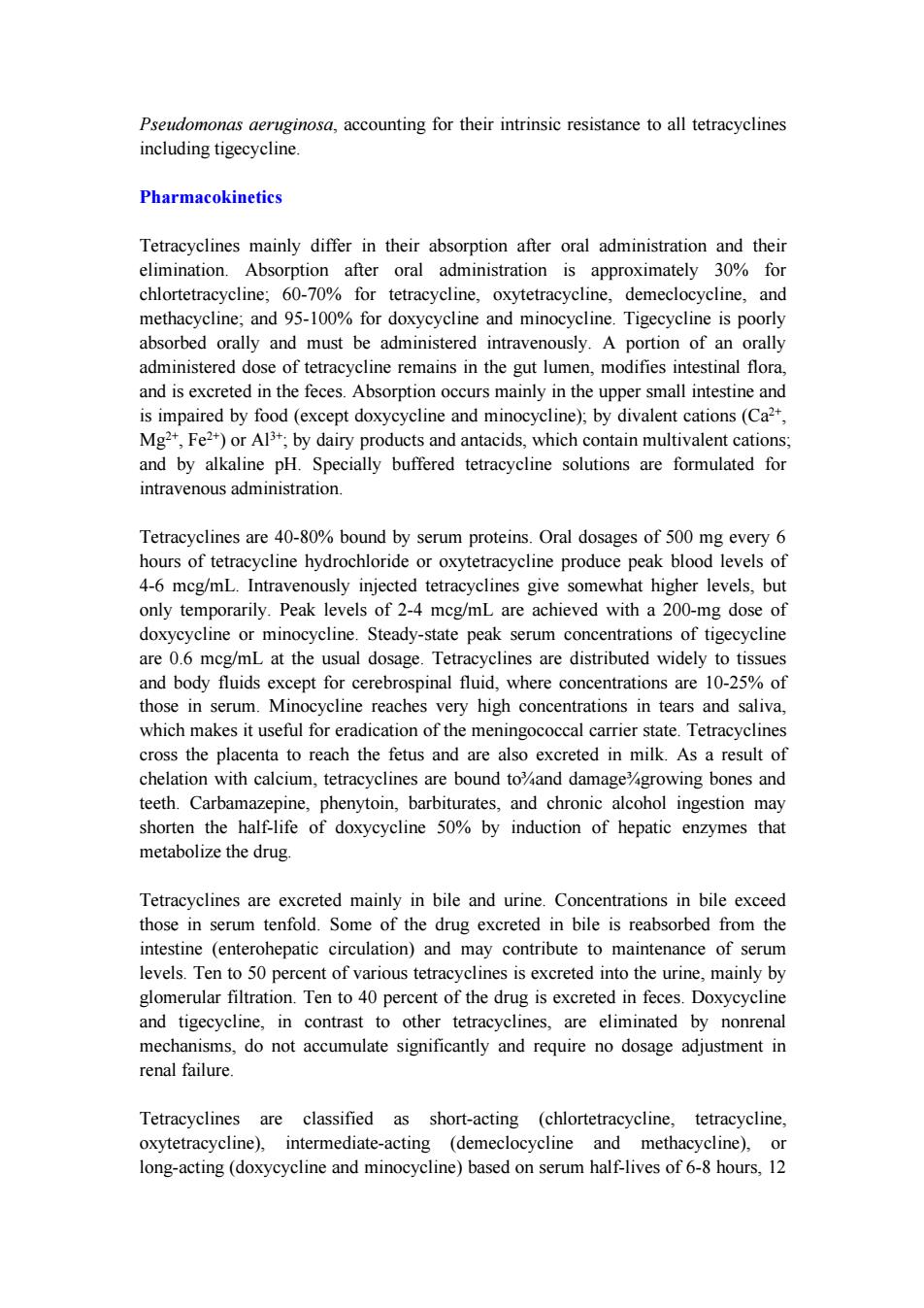正在加载图片...

Pseudomonas aeruginosa,accounting for their intrinsic resistance to all tetracyclines including tigecycline Pharmacokinetics Tetracyclines mainly differ in their absorption after oral administration and their elimination.Absorption after oral administration is approximately 30%for chlortetracycline;60-70%for tetracycline,oxytetracycline,demeclocycline,and methacycline;and 95-100%for doxycycline and minocycline.Tigecycline is poorly absorbed orally and must be administered intravenously.A portion of an orally administered dose of tetracycline remains in the gut lumen,modifies intestinal flora, and is excreted in the feces.Absorption occurs mainly in the upper small intestine and is impaired by food (except doxycycline and minocycline);by divalent cations(Ca2+, Mg2+,Fe2+)or Al3+;by dairy products and antacids,which contain multivalent cations; and by alkaline pH.Specially buffered tetracycline solutions are formulated for intravenous administration. Tetracyclines are 40-80%bound by serum proteins.Oral dosages of 500 mg every 6 hours of tetracycline hydrochloride or oxytetracycline produce peak blood levels of 4-6 mcg/mL.Intravenously injected tetracyclines give somewhat higher levels,but only temporarily.Peak levels of 2-4 mcg/mL are achieved with a 200-mg dose of doxycycline or minocycline.Steady-state peak serum concentrations of tigecycline are 0.6 mcg/mL at the usual dosage.Tetracyclines are distributed widely to tissues and body fluids except for cerebrospinal fluid,where concentrations are 10-25%of those in serum.Minocycline reaches very high concentrations in tears and saliva, which makes it useful for eradication of the meningococcal carrier state.Tetracyclines cross the placenta to reach the fetus and are also excreted in milk.As a result of chelation with calcium,tetracyclines are bound to and damage%growing bones and teeth.Carbamazepine,phenytoin,barbiturates,and chronic alcohol ingestion may shorten the half-life of doxycycline 50%by induction of hepatic enzymes that metabolize the drug. Tetracyclines are excreted mainly in bile and urine.Concentrations in bile exceed those in serum tenfold.Some of the drug excreted in bile is reabsorbed from the intestine (enterohepatic circulation)and may contribute to maintenance of serum levels.Ten to 50 percent of various tetracyclines is excreted into the urine,mainly by glomerular filtration.Ten to 40 percent of the drug is excreted in feces.Doxycycline and tigecycline,in contrast to other tetracyclines,are eliminated by nonrenal mechanisms,do not accumulate significantly and require no dosage adjustment in renal failure Tetracyclines are classified as short-acting (chlortetracycline,tetracycline, oxytetracycline),intermediate-acting (demeclocycline and methacycline),or long-acting(doxycycline and minocycline)based on serum half-lives of 6-8 hours,12Pseudomonas aeruginosa, accounting for their intrinsic resistance to all tetracyclines including tigecycline. Pharmacokinetics Tetracyclines mainly differ in their absorption after oral administration and their elimination. Absorption after oral administration is approximately 30% for chlortetracycline; 60-70% for tetracycline, oxytetracycline, demeclocycline, and methacycline; and 95-100% for doxycycline and minocycline. Tigecycline is poorly absorbed orally and must be administered intravenously. A portion of an orally administered dose of tetracycline remains in the gut lumen, modifies intestinal flora, and is excreted in the feces. Absorption occurs mainly in the upper small intestine and is impaired by food (except doxycycline and minocycline); by divalent cations (Ca 2+ , Mg 2+ , Fe 2+ ) or Al3+ ; by dairy products and antacids, which contain multivalent cations; and by alkaline pH. Specially buffered tetracycline solutions are formulated for intravenous administration. Tetracyclines are 40-80% bound by serum proteins. Oral dosages of 500 mg every 6 hours of tetracycline hydrochloride or oxytetracycline produce peak blood levels of 4-6 mcg/mL. Intravenously injected tetracyclines give somewhat higher levels, but only temporarily. Peak levels of 2-4 mcg/mL are achieved with a 200-mg dose of doxycycline or minocycline. Steady-state peak serum concentrations of tigecycline are 0.6 mcg/mL at the usual dosage. Tetracyclines are distributed widely to tissues and body fluids except for cerebrospinal fluid, where concentrations are 10-25% of those in serum. Minocycline reaches very high concentrations in tears and saliva, which makes it useful for eradication of the meningococcal carrier state. Tetracyclines cross the placenta to reach the fetus and are also excreted in milk. As a result of chelation with calcium, tetracyclines are bound to¾and damage¾growing bones and teeth. Carbamazepine, phenytoin, barbiturates, and chronic alcohol ingestion may shorten the half-life of doxycycline 50% by induction of hepatic enzymes that metabolize the drug. Tetracyclines are excreted mainly in bile and urine. Concentrations in bile exceed those in serum tenfold. Some of the drug excreted in bile is reabsorbed from the intestine (enterohepatic circulation) and may contribute to maintenance of serum levels. Ten to 50 percent of various tetracyclines is excreted into the urine, mainly by glomerular filtration. Ten to 40 percent of the drug is excreted in feces. Doxycycline and tigecycline, in contrast to other tetracyclines, are eliminated by nonrenal mechanisms, do not accumulate significantly and require no dosage adjustment in renal failure. Tetracyclines are classified as short-acting (chlortetracycline, tetracycline, oxytetracycline), intermediate-acting (demeclocycline and methacycline), or long-acting (doxycycline and minocycline) based on serum half-lives of 6-8 hours, 12